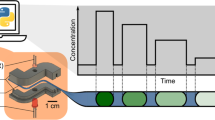Summary
Using the system depicted in figure 4, consisting of a pulse-type microreactor coupled to a highresolving capillary we are able to analyze the resultant product mixtures. A cold trap is incorporated between the reactor and the capillary column. The construction ensures the correct pressure relationships at the column entrace (stream splitter) which are vital for exact qualitative and/or quantitative analyses.
This applies to the following two cases:
-
1.
continuous-flow system: the trap is heated and hence no products are fronzen out;
-
2.
stop-flow system: the products are collected in the trap and evaporated in a subsequent heating period for analysis. This can be accomplished in two ways
-
2.1.
in case of low boiling or thermally sensitive substances the carrier gas flow through the trap is not inyterrupted;
-
2.2.
in case of mixtures having components with a large volatility difference or better thermal stability the direction of the carrier gas flow is diverted prior to the introduction of the sample plug into the capillary.
Zusammenfassung
Wir sind mit der in Fig. 4 skizzierten Versuchsanordnung in der Lage, einen im “in-line”-Pulsbetrieb arbeitenden Mikroreaktor mit einer hochauflösenden Trennkapillare zu koppeln und die entstehenden Reaktionsgemische zu analysieren. Dabei verwenden wir eine Konstruktion, bei der zwischen Reaktor und Trennkapillare eine Kühlfalle sitzt. Durch die gewählte Anordnung (Pneumatik) wird gesichert, daß an der Splitstelle jene Druckverhältnisse herrschen, welche im Hinblick auf exakte qualitative und (oder) quantitative Auswertungen entscheiden sind. Dieses gilt:
-
1.
im kontinuierlichen Betrieb, d.h. ohne die Reaktionsprodukte auszufrieren, durch Heizung oder Entfermung der Kühlfalle, und
-
2.
im diskontinuierlichen Betrieb, d.h. mit Auffangen und Sammeln der Produkte in der Kühlfalle. Während deren Aufheizperiode (Verdampfung der Produkte zwecks nachfolgender Analyse) kann nach zwei Methoden gearbeitet werden:
-
2.1.
bei niedrigsiedenden oder thermisch empfindlichen Substanzen ohne den Trägergasstrom durch die Kühlfalle zu unterbrechen, oder
-
2.2.
bei einem Substanzgemisch, dessen Komponenten sich in ihrer Flüchtigkeit stark unterscheiden, und die thermisch weniger empfindlich sind, mit vorherigem Umschalten des Strömungsweges und Einspülen des Gaspfropfens in das Trennsystem.
Résumé
En utilisant l'appareillage décrit à la figure 4, comprenant un microréacteur couplé («en ligne») à une colonnee capillaire il nous a été possible d'analyser les produits volatils formés pendant la réaction. Le système comprend, entre le réacteur et la colonne, un piège refroidi. Par un dispositif pneumatique, nous assurons au système de division une pression constante telle qu'il soit possible d'obtenir une bonne réponse à la foi du point de vue qualitatif et (ou) quantitatif. Ceci a été appliqué dans deux cas:
-
1.
en fonctionnement continu (Procédé à débit continu): par exemple, le piège est chauffé et aucun produit n'est retenu par congélation;
-
2.
en fonctionnement discontinu (Procédé à débit interrompu): par exemples, les produits sont arrètés par le piège puis pendant la periode de chauffage du piège les substances sont évaporées en vue de leur analyse ultérieure. Ceci peut être réalisé de deux manières:
-
2.1.
dans le cas des substances ayant un bas point d'ébulition ou sensibles à la chaleur, le courant du gaz vecteur à travers le piège n'est pas interrompu
-
2.2.
dans le cas des produits ayant une grande différence de volatilité ou moins sensibles à la chaleur on coupe d'abord le courant de gaz vecteur et on introduit ensuite l'échantillon gazeux dans le système de séparation.
Similar content being viewed by others
Schrifttum
G. Schomburg, Chromatographia,4, 286 (1971)
R. G. Schaefer, Dissertation Universität Bochum 1970
R. J. Kokes, H. Tobin undP. H. Emmett. J. Am. Chem. Soc.,77, 5860 (1955)
M. Beroza undR. A. Coad, inL. S. Ettre undA. Zlatkis (Herausgeber): “The Practice of Gas Chromatography”, New York 1969, S. 498
P. Steingaszner, inL. S. Ettre undW. H. McFadden (Herausgeber): “Ancillary Techniques of Gas Chromatography”, New York 1969, S. 13.
R. W. Dunning undJ. A. Leonard, Chromatographia,2, 293 (1969).
D. W. Basset undH. W. Habgood, J. Phys. Chem.,64, 769 (1960)
R. Kaiser, i “Chromatographie in der Gasphase”, 2. Teil, 2. Aufl., Mannheim 1966, S. 192
R. L. Banks undG. C. Bailey, Ind. Eng. Chem. Prod. Res. Develop.,3, 170 (1964).
G. C. Bailey, Catalysis Review,3 (1), 37 (1969)
K. K. Kearby, Ind. Eng. Chem.,42, 295 (1950).
Author information
Authors and Affiliations
Rights and permissions
About this article
Cite this article
Schaefer, R.G., Schomburg, G. Zur Kopplung von katalytischen Mikroreaktoren mit Trennkapillaren. Chromatographia 4, 508–515 (1971). https://doi.org/10.1007/BF02314901
Received:
Accepted:
Issue Date:
DOI: https://doi.org/10.1007/BF02314901




